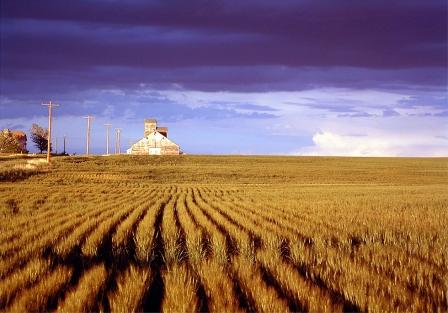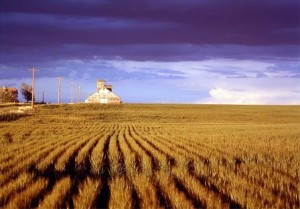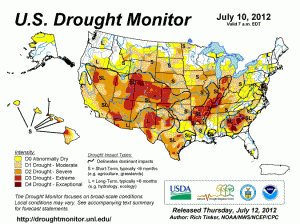
Drought in America’s Corn Belt Worsens; Food Prices Likely to Rise
 According to the July 10 release of the National Drought Monitor from the National Oceanic and Atmospheric Administration and the National Drought Mitigation Center, roughly 61% of the contiguous United States is in drought. The only areas that are completely drought-free are Alaska and the New England states. The extreme heat wave in June and July, coupled with decreased rainfall, has had devastating effects on our nation’s corn crops. This drought has hit farmers and ranchers hard, and is likely to inflate food prices, even if the droughts ended today.
According to the July 10 release of the National Drought Monitor from the National Oceanic and Atmospheric Administration and the National Drought Mitigation Center, roughly 61% of the contiguous United States is in drought. The only areas that are completely drought-free are Alaska and the New England states. The extreme heat wave in June and July, coupled with decreased rainfall, has had devastating effects on our nation’s corn crops. This drought has hit farmers and ranchers hard, and is likely to inflate food prices, even if the droughts ended today.
The US Department of Agriculture has declared disaster areas in 1,016 counties in 26 US States, making it the largest natural disaster area in US history. 60% of all corn in the country is experiencing moderate to extreme drought conditions and the USDA officially cut its yield forecast by 12%. In Iowa, the top U.S. corn producer, only 42% of corn crops are rated good to excellent, down from 62% a week earlier and 82% a year ago. It is estimated that farmers and ranchers have already suffered billions of dollars in damage. Even if the drought doesn’t get considerably worse, food prices are already expected to rise, based on the high price of corn. The prices of corn have risen more than 40% in recent weeks.
At the beginning of the year, the US Department of Agriculture reported that farmers had planted 96.4 million acres of corn, the most since the end of the Great Depression in 1937. This increase came in direct response to high commodity prices. Corn was expected to sell for $5 a bushel this year due to the increase in production. Instead, corn was selling for $7.50 a bushel last week, reflecting the effects of the drought in the Corn Belt. Because corn is the major source of feed for livestock, beef, dairy and poultry products will likely increase with them. This will eventually raise food prices for the consumer. The 50% increase in food prices adds about $75 to $80 a head to cattle production costs, which may lead to an increase of up to 6% for the consumer.
Agriculture is a major part of our nation’s economy, as the US continues to be the largest producer of corn in the world. US corn exports are vital to the US economy, and production of course grains (corn, barley, oats, etc) being used primarily for feed. These recent droughts remind us how vulnerable our crops are to changes in climate, especially extreme weather that we have been facing. US Agriculture Secretary Tom Vilsack said recently, “We need to be cognizant of the fact that drought and weather conditions have severely impacted farmers around the country.” We must also be cognizant of the fact that we, as a nation, are dependent on our corn and soybean crops for economic and food security. Our crops feed our livestock, which puts food on our tables. The same goes for other countries all over the world. Our grains help feel livestock all around the world, thereby feeding people. As corn prices rise, global population increases and climates fluctuate, food security will be a major challenge.






[…] the country’s largest export crop, down by 12%. This, and any subsequent adjustments, will likely impact global corn prices, but also meat and dairy prices, as corn is used for animal feed. Meanwhile, beef prices are still […]
[…] country’s largest export crop, down by 12%. This, and any subsequent adjustments, will likely impact global corn prices, but also meat and dairy prices, as corn is used for animal feed. Meanwhile, beef prices are still […]
[…] the country’s largest export crop, down by 12%. This, and any subsequent adjustments, will likely impact global corn prices, but also meat and dairy prices, as corn is used for animal feed. Meanwhile, beef prices are still […]
[…] the country’s largest export crop, down by 12%. This, and any subsequent adjustments, will likely impact global corn prices, but also meat and dairy prices, as corn is used for animal feed. Meanwhile, beef prices are still […]
[…] largest export crop, down by 12 percent. This, and any subsequent adjustments, will likely impact global corn prices, but also meat and dairy prices, as corn is used for animal feed. Meanwhile, beef prices are still […]
[…] largest export crop, down by 12 percent. This, and any subsequent adjustments, will likely impact global corn prices, but also meat and dairy prices, as corn is used for animal feed. Meanwhile, beef prices are still […]
[…] largest export crop, down by 12 percent. This, and any subsequent adjustments, will likely impact global corn prices, but also meat and dairy prices, as corn is used for animal feed. Meanwhile, beef prices are still […]
… [Trackback]…
[…] Find More Informations here: americansecurityproject.org/blog/2012/drought-in-americas-corn-belt-worsens-food-prices-likely-to-rise/ […]…